Course Power Tools allow you to do bulk operations when building or modifying your course, including inserts, deleting, moving, cloning, and even importing from other Courses.
When working in the Course Builder, bring them up by clicking the "Power tools..." button as found toward the bottom of the Course Builder Tools.
Note: All screenshots and words here reference "steps", as in a Step-based Course, but the same applies to "days" in Day-based Courses.
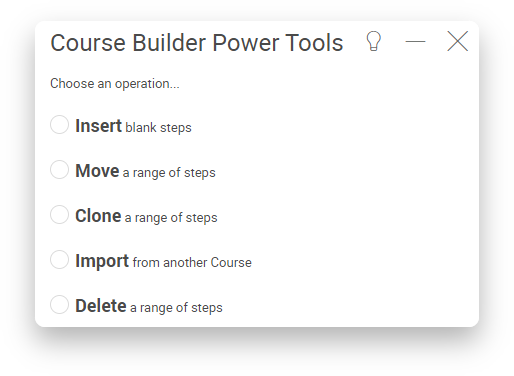
There are 5 operations to choose from.
Insert blank steps
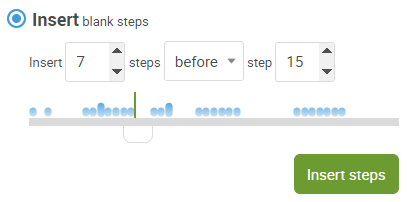
This allows you to quickly insert a number of steps into the timeline at whatever part you like.
Here, and in other operations, you are setting what we'll call the operation point, or "the point in the course timeline at which this operation should occur"
(i.e. in this example "where in the Course timeline should these 7 steps be inserted?") In the screenshot above, the controls are set for the operation point to be before step 15, i.e. we're saying "the
7 steps should be inserted right between step 14 and 15".
Notice here, as we'll see with other power tool operations, the gray navigation line and the slider control knob just below it. As an alternative to specifying the operation point as number inputs , you can do so visually be dragging that control knob along the length of that line. The little blue markers show the distribution of items in your course, and the sharp green line shows the currently chosen
operation point.
Change visual slider, and the number input will correspondingly change, and vice versa. It's kinda fun!
Move a range of steps
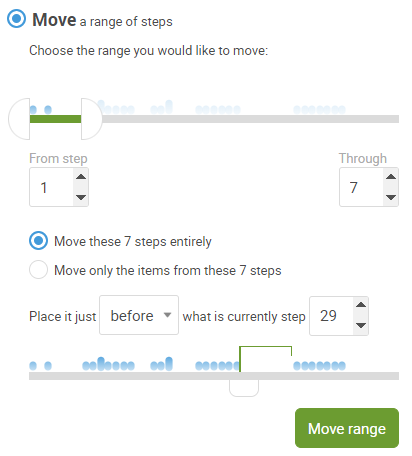
This allows you to select a particular range of steps in your timeline and move them (or just the items of those steps) elsewhere.
This operation introduces the notion of specifying what we'll call a course range, or "the segment of one or more steps from the timeline that we're selecting for the operation". Like choosing the operation point, we'll see selecting the course range throughout these power tools.
Also like choosing the operation point, you can do so from the number controls as well as draggable knobs (the two half circles which cordon off the lower and upper limits of the range) on the timeline slider.
Again, change the range by dragging a knob on the visual slider, and the number input will correspondingly change. And vice versa. It, too, is kinda fun. :)
When it comes to making a move of a range in the course that you've selected, you've got two ways to choose from:
- Move the steps entirely. That means any items in those steps (and indeed, currently active participants who happen to be on one of those steps!) will come along for the ride. There are never any holes on the timeline, so when you move steps, those steps around that move will be shuffled in to fill in the gap, effectively causing a swap in the ordering on the timeline. (Be warned: this always operates as it should, but it can be confusing!)
- Move only the items. This means the steps will stay where they are, and the items from those steps will be layered on to whatever steps are implied by the operation point.
This too, has fun-ness about it.
If you choose an operation point for a move that would have the selected range fall off the end of the timeline, the duration of the course will automatically be extended to ensure that nothing falls off the edge and into oblivion. :)
Cloning a range of steps
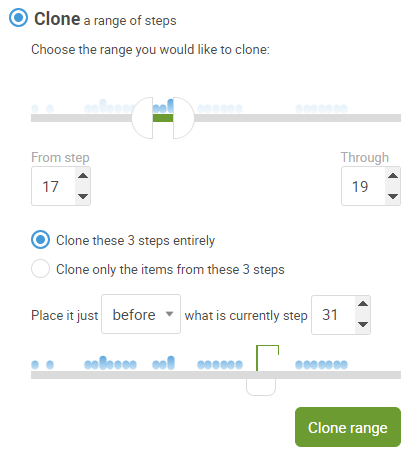
Similar to move, this allows you to select a particular range of steps in your timeline and clone them (or just clone the items of those steps) elsewhere.
Like move, there are two options for cloning:
- Clone the steps entirely. This means wherever you place the cloned range, the steps the follow that point will be pushed down accordingly
- Clone only the items. This means all steps will stay where they are, and the items from those cloned steps will be layered on to whatever steps are implied by the operation point. To prevent likely unintentional mistakes, you're not able to clone a range to a location that has any overlap with itself.
Import a range of steps
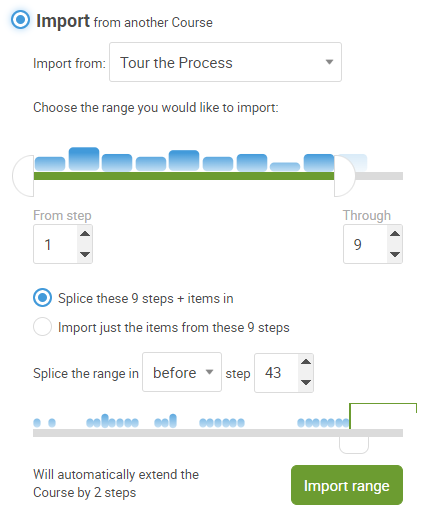
This allows you to build up a course by combining segments from other courses.
Just like clone, you first select a range from the course you'll be importing from, choose whether to add in steps in their entirety or just the items from them, and choose the operation point in your current course to import those steps and/or items.
As mentioned above, note how in this screenshot a range that implies going off the edge of the current course's timeline means that the course will automatically be extended for you (as the little "Will automatically extend..." message indicates).
Delete a range of steps
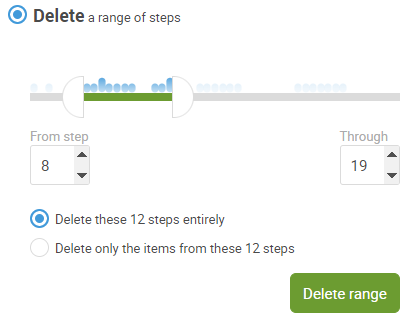
Delete works exactly as you'd expect, consistent with the same rules of other power tools: choose a range, and choose whether this it to affect steps in that range entirely or just the items within.
It's ALMOST like an undo button for inserting, cloning, and importing.
Speaking of undo buttons...
A Power Tools Word of Caution
There is to be careful when using these power tools. None of them come with any sort of undo button. Just as a table saw will take a finger if you're not paying attention, it is very easy to make a huge mess of your courses if you use these without care.
The delete operation will ask you to click to confirm, but it will only do so once and then, as everything else in CoachAccountable, dutifully proceed to do what you told it to. :)
If you're nervous, you can make a clone of your course first, to serve as a backup.
Extra special care should be taken when operating on a course that has active participants in it.